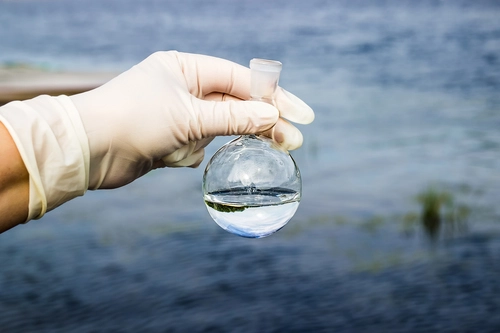
On October 18, 2021, the Biden-Harris administration announced an updated government-wide “comprehensive approach” to address per- and polyfluoroalkyl substances (PFAS), a set of man-made chemicals that are widely used in a variety of consumer and industrial products, and which persist in the environment once released and may be linked to health impacts. The announcement identified several activities to address PFAS by eight federal agencies, as well as proposed funding in the forthcoming infrastructure bill for monitoring for PFAS compounds in drinking water through the Unregulated Contaminant Monitoring Rule (UCMR), and community grants to address emerging contaminants (including PFAS).
The administration’s announcement also included numerous non-regulatory actions and PFAS-related research priorities, including research by the Federal Aviation Administration and the Department of Defense (DOD) to identify a PFAS-free firefighting foam alternative. DOD is also conducting cleanup assessments at several of its properties where PFAS may have been used or released, and expects to complete the assessments by the end of 2023.
Also on October 18, EPA released its new PFAS Strategic Roadmap. The Roadmap identifies several specific actions EPA plans to take with respect to PFAS, and rough targets for when EPA expects to complete those actions between now and 2024. Broadly speaking, EPA describes its approach as focused on three central directives: research, restrict and remediate. That is, EPA intends to invest in research to better understand PFAS, including the toxicity and human health and ecological effects of PFAS; restrict the use and disposal of PFAS to prevent them from entering the environment at levels that could adversely impact human health and the environment; and clean up PFAS contamination in order to protect human health and ecological systems.
EPA is hosting public webinars to engage with stakeholders and discuss its PFAS Strategic Roadmap. The next webinar will take place on November 2, and registration information is available at the link.
In addition to numerous research activities, EPA has identified several regulatory actions that will affect water suppliers, industries that use PFAS chemicals, and properties where PFAS may have been released into the environment. Among the many activities EPA has included in its Roadmap, EPA has identified the following actions in specific program areas:
Drinking Water and Wastewater Regulation
- Including 29 PFAS compounds in UCMR 5. As proposed, and if funding is appropriated by Congress, the rule would require public water systems serving 3,300 or more people and 800 representative public water systems serving fewer than 3,300 people to collect samples during a twelve-month period between January 2023 and December 2025 to test for contaminants including 29 PFAS chemicals. EPA expects to finalize the rule by fall 2021.
- National primary drinking water regulation for PFOA and PFOS. In March 2021, EPA published the Fourth Regulatory Determinations under the Safe Drinking Water Act, including a final determination to regulate perfluorooctanoic acid (PFOA) and perfluorooctane sulfonic acid (PFOS), the two PFAS compounds made in the largest amounts in the United States. EPA expects to issue a proposed national primary drinking water regulation for those chemicals in fall 2022, ahead of the March 2023 deadline for the proposed rule, and to issue a final regulation in fall 2023. EPA will also continue to evaluate primary drinking water regulations for additional PFAS chemicals.
- Final toxicity assessments for GenX chemicals and other PFAS compounds. EPA plans to publish toxicity assessments for two PFAS known as “GenX chemicals” in fall 2021, and is developing toxicity assessments for five other PFAS (PFBA, PFHxA, PFHxS, PFNA and PFDA).
- Health advisories for GenX and PFBS. By spring 2022, EPA will publish health advisories–non-enforceable guidelines that define a level of drinking water concentration, at or below which lifetime exposure is not anticipated to lead to adverse health effects–for PFBS and GenX chemicals. The health advisories will based on the final toxicity assessments for those chemicals, and EPA plans to develop additional health advisories as the agency completes toxicity assessments for additional PFAS.
- Effluent Limitation Guidelines. EPA expects to propose effluent limitation guidelines for PFAS in wastewater from specified industrial categories in 2023 and 2024, and is studying other industrial facilities to support potential rulemakings relating to PFAS in wastewater from those industries. EPA also expects to begin working with states to propose monitoring requirements for PFAS in NPDES permits for facilities where PFAS are expected or suspected to be present in wastewater or stormwater discharges.
Site Remediation
- CERCLA hazardous substance designation for PFOA and PFOS. EPA will propose a rule designating PFOA and PFOS as hazardous substances under CERCLA by spring of 2022, with a final rule expected by summer of 2023. The rule may also require reporting of releases of PFOA or PFOS that meet or exceed a reportable quantity (RQ), and would allow parties to seek cost recovery or contribution for the cost of remediating those substances.
- Advanced Notice of Proposed Rulemaking (ANPR) for hazardous substance designations. By spring 2022, EPA expects to publish an ANPR seeking public input on whether to designate additional PFAS as CERCLA hazardous substances. EPA will determine which PFAS to include in the ANPR based on specific information on the health effects of specific PFAS, methods to measure concentrations of PFAS in groundwater and engagement with communities near PFAS-contaminated sites.
- Updated guidance on destroying/disposing of PFAS and PFAS-containing materials. The 2020 National Defense Authorization Act (NDAA) required EPA to publish interim guidance on destroying and disposing of PFAS and certain identified non-consumer PFAS-containing materials, and requires EPA to revise that guidance at least every three years. EPA’s first interim guidance was published in December 2020, and EPA plans to update that guidance to reflect public comments and new research results no later than December 2023.
EPA will also create a national PFAS testing strategy, and exercise its authority under the Toxic Substance Control Act to require manufacturers to conduct and fund priority research, and plans to propose a rulemaking in 2022 to require additional reporting on releases of PFAS under the Toxics Release Inventory (TRI) program.
EPA’s PFAS Strategic Roadmap identifies extensive planned research and regulatory actions, and Nossaman will continue to post updates as EPA takes additional actions.
- Partner
Willis Hon focuses on serving water industry clients across California on a broad range of administrative and regulatory matters. He has extensive experience before the California Public Utilities Commission where he has ...
California Water Views provides timely and insightful updates on the water sector in the state. We relay information on how water legislation and policy from the nation’s capital, Sacramento, and around the U.S. affect California’s water utilities, agencies, practitioners, and consumers. We also write about important events, conferences, legal cases, and other key happenings involving all things water in and around California.
Stay Connected
 RSS Feed
RSS Feed
Categories
- Clean Up of Groundwater & Contaminated Media
- Climate Change
- Coastal Development
- Construction
- COVID-19
- Dam Construction, Operation & Removal
- Desalination
- Environmental Protection Agency
- Events
- Government Administration
- Groundwater Management & SGMA
- Inverse Condemnation & Regulatory Takings
- New Legislation
- Oceans, Marine Life & Maritime Transportation
- Project Construction
- Projects
- Public Agency Regulation
- Recycled Water
- Regulatory Reform & Proposed Rules
- Right to Take
- Valuation
- Water Infrastructure
- Water Litigation
- Water Quality
- Water Rights
- Water Supply
- Water Utility Regulation

